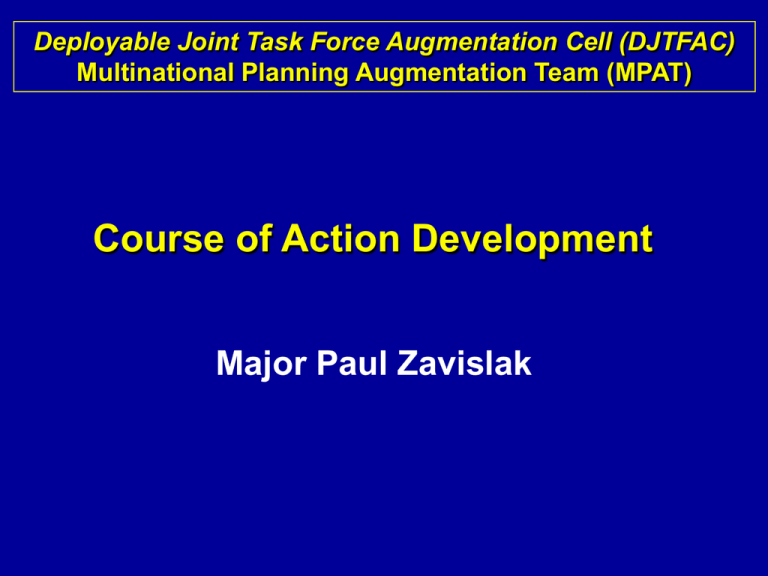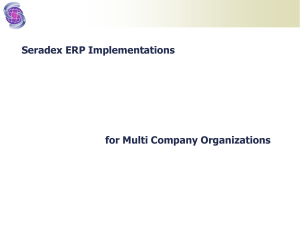COADevelopmt - APAN Community SharePoint
advertisement

Deployable Joint Task Force Augmentation Cell (DJTFAC) Multinational Planning Augmentation Team (MPAT) Course of Action Development Major Paul Zavislak Purpose Discuss techniques and procedures for developing courses of action – Operational level – Course of Action (COA) must be valid References Chairman, Joint Chiefs of Staff Manual 3500.05, CTF Headquarters Master Training Guide, 15 April 1997 Joint JP Pub 5-0, Doctrine for Planning Joint Operations, 13 April 1995 5-00.2, Joint Task Force Planning Guidance and Procedures, 13 January 1999 CJCSM 3122.01, Joint Operation Planning and Execution System, Volume I, (Planning Policies and Procedures), 14 July 2000, Chg 1 25 May 2001 Crisis Action Planning Process C R I S I S I Situation Development II Crisis Assessment III Course of Action Development IV Course of Action Selection V Execution Planning OPORD VI & Deployment Execution Data Base And/or Warning Order I Mission Analysis II Course of Action Development Planning Order III Analysis of Opposing Courses of Action Alert Order IV Comparison of Own Courses of Action Execute Order V Commander’s Decision Course of Action Development The COA is a broad statement of one way to accomplish a mission. WHO - will accomplish essential tasks WHAT - is the type of mission to be conducted Develop WHEN - the operation must begin or must be completed Initial COAs WHERE - the combined operation will be executed Initial Test WHY - or the purpose of the operation for Validity HOW - or the method of conducting the Determine operation using major available C2 Means resources COA Statement & Sketch Brief COAs to CCTF CCTF Approves COAs Staff estimates Task Steps Vertical & Horizontal planning Prepare for COA Development Plan to plan One big group? Several groups? Brainstorm Simultaneous or sequential development? Be bold in concept Be general by component Be open to new ideas Be unconstrained COA Development—Things to Avoid The intended COA The clone of the Intended COA The throw away Nested COAs The commander may make the decision before all the facts are gathered and analysis is complete Develop Initial COAs Develop Initial COAs Initial Test for Validity Review mission analysis / CTF commander planning guidance Determine C2 Means Develop plans to integrate the multinational environment COA Statement & Sketch Brief COAs to CCTF Focus on centers of gravity Identify sequencing and phasing for each COA Identify main and supporting efforts CCTF Approves COAs Identify component level missions/tasks Staff estimates Develop information operations support items Vertical & horizontal planning Course of Action Development Test COA Validity Develop Initial COAs Initial Test for Validity Is the COA suitable? Determine C2 Means Is the COA feasible? Is the COA acceptable? Is the COA complete? Are the COAs distinguishable? COA Statement & Sketch Brief COAs to CCTF CCTF Approves COAs Staff estimates Vertical & horizontal planning Course of Action Development Test COA Validity SUITABLE FEASIBLE Will the COA: – – – – – Accomplish Msn? Meet Cmdr’s Intent? Accomplish all essential tasks? Meet conditions of desired endstate? Consider COG on both sides? ACCEPTABLE Do we have the required resources to accomplish the mission and will they be available in the operations area in time? Forces / Capability Strategic Lift / Transportation Sustainment / Resupply Support facilities Even though the action will accomplish the mission and we have the necessary resources, is it worth cost in terms of possible losses (ie. Risk). Besides just military losses, the CCTF must consider: Loss in Position Legal / Ethical Loss in Time Political Acceptability Test COA Validity Are the COAs significantly different From CCTF perspective? DISTINGUISHABLE From the perspective of HHQ? From the perspective of the coalition NCA? ie. main effort, scheme of employment, task org,reserve use Are the COAs technically complete? Will the COAs: COMPLETE WHO will execute it? WHAT type of action is contemplated? WHEN will it begin? WHERE will it take place? HOW will it be accomplished? WHY key actions are required? JP 5-00.2, IX-44 Determine Command & Control Means Develop Initial COAs Initial Test for Validity – Operational Control (OPCON) – Tactical Control (TACON) – Support (general, direct, close) Determine C2 Means COA Statement & Sketch Brief COAs to CCTF CCTF Approves COAs Staff estimates Vertical & horizontal planning Determine command relationships Organizational options – Service components – Functional components – Subordinate CTF or TF Determine control measures Course of Action Development CTF Organizational Structure Examples CCTF “X” FORCES NATIONAL C2 STRUCTURE “Y” FORCES COALITION – AD HOC COMBINED – ALLIANCE, TREATY OR OTHER FORMAL AGREEMENT FUNCTIONAL C2 STRUCTURE CNAVFOR CARFOR CAFFOR CCTF CMARFOR CSOTF CPOTF Historically, national component structure has been used in coalition operations, and functional component structure in allied operations Prepare COA Statement, Sketch, & Task Organization Develop Initial COAs Initial Test for Validity Determine C2 Means COA Statement & Sketch Brief COAs to CCTF CCTF Approves COAs Staff estimates COA statement answers WHO, WHAT, WHERE, WHEN, WHY, HOW Develop COA sketch (by phase) Task organize the force Initial organization – One level down – Vertical & horizontal planning Course of Action Development Phase 3: Conduct HA/DR Operations CTF HQ: Provide C2; NGO / PVO / IO coordination; transition planning; information ops; relocate to forward location CTG A CTG A: conduct HA/DR ops ISO VISCOM; conduct info ops; coordinate with NGO / PVO / IO; prepare for redeployment CTG B: conduct HA/DR ops ISO SOUTHCOM; conduct info ops; coordinate with NGO / PVO / IO; prepare for redeployment CTG B CFACC: Support HA/DR ops CFMCC: Support HA/DR ops; redeploy HQ as required This phase starts with lodgment of forces and ends when transition criteria are met; the main effort is CTG A. Develop Initial COAs Initial Test for Validity Determine C2 Means COA Statement & Sketch Brief COAs to CCTF CCTF Approves COAs Staff estimates Brief Courses of Action to Commander of Coalition / Combined Task Force (CCTF) * initial COA brief Vertical & horizontal planning Course of Action Development CCTF Consideration of the COAs Develop Initial COAs Initial Test for Validity Review and approve COAs for further analysis Direct revisions to COAs, combinations of COAs, or development of additional COAs Determine C2 Means COA Statement & Sketch Brief COAs to CCTF CCTF Approves COAs Staff estimates Vertical & horizontal planning Commander’s Guidance Vital During This Step! Course of Action Development Conduct Initial Staff Estimates Develop Initial COAs Initial Test for Validity Each staff addresses each COA from its own perspective Staff prepares for COA analysis, COA comparison, and COA recommendation and selection Determine C2 Means COA Statement & Sketch Brief COAs to CCTF CCTF Approves COAs Staff estimates Vertical & horizontal planning Course of Action Development Continue Concurrent Planning Communicate and Coordinate! Develop Initial COAs Initial Test for Validity Discuss planning status with counterparts, higher and lower Coordinate planning with staff counterparts from other functional areas Permits adjustments in planning Determine C2 Means COA Statement & Sketch Brief COAs to CCTF CCTF Approves COAs Staff estimates Vertical & horizontal planning Course of Action Development Course of Action Development The COA is a broad statement of one way to accomplish a mission. WHO - will accomplish essential tasks WHAT - is the type of mission to be conducted Develop WHEN - the operation must begin or must be completed Initial COAs WHERE - the combined operation will be executed Initial Test WHY - or the purpose of the operation for Validity HOW - or the method of conducting the Determine operation using major available C2 Means resources COA Statement & Sketch Brief COAs to CCTF CCTF Approves COAs Staff estimates Task Steps Vertical & Horizontal planning Deployable Joint Task Force Augmentation Cell (DJTFAC) Multinational Planning Augmentation Team (MPAT) Course of Action Development Questions?







